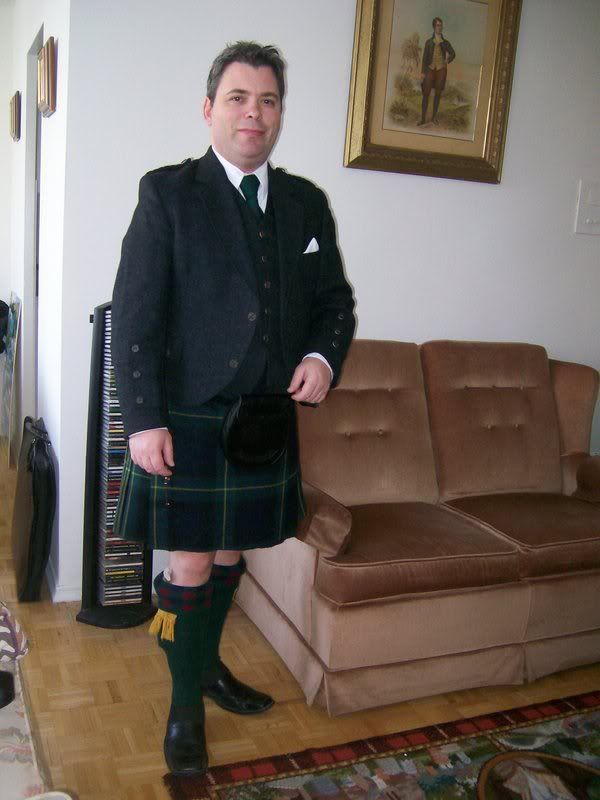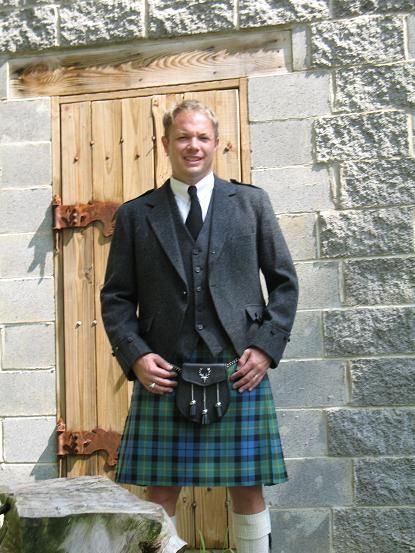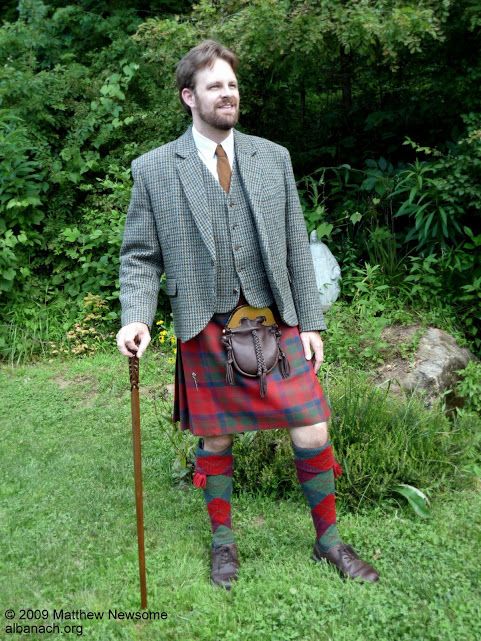|
-
9th October 16, 01:54 PM
#11
 Originally Posted by Steve Ashton

And Jock, that is why I used the traditional concept that Tweeds were "country" wear.
I say this with the greatest of respect Steve, but your view that tweed is "country wear" is entirely wrong from a traditional kilt wear point of view.Tweed in town is also absolutely acceptable kilt attire from a traditional point of view in Scotland. I think this explains why many of your views about traditional kilt wear have been at odds with the mainstream traditional kilt wearers that visit this part of your website.
" Rules are for the guidance of wise men and the adherence of idle minds and minor tyrants". Field Marshal Lord Slim.
-
The Following 4 Users say 'Aye' to Jock Scot For This Useful Post:
-
9th October 16, 11:10 PM
#12
Excerpted from "The curiously compelling story of Tweed" originally published by "The Gentleman's Gazette" .
"Tweed was the ideal sporting attire of the 19th and early 20th-century gentleman and as such it was the performance fabric of its time. The English gentry quickly adopted tweed as the ideal outdoor cloth on their upcountry estates. Wearing tweed made hunting, shooting, and fishing comfortably enjoyable pastimes.
Tweed also became popular among the 19th-century Victorian middle classes who associated it with the leisurely pursuits of the aristocracy. It was worn for virtually every sporting and adventure endeavor including golf, cycling, tennis, motoring, and mountain climbing."
Heck, even Wiki says
"Tweeds are an icon of traditional Irish and British country clothing, being desirable for informal outerwear, due to the material being moisture-resistant and durable. Tweeds are made to withstand harsh climate and are commonly worn for outdoor activities such as shooting and hunting, in both Ireland and the United Kingdom."
Last edited by Steve Ashton; 9th October 16 at 11:24 PM.
-
-
10th October 16, 12:13 AM
#13
 Originally Posted by Steve Ashton

Excerpted from "The curiously compelling story of Tweed" originally published by "The Gentleman's Gazette" .
"Tweed was the ideal sporting attire of the 19th and early 20th-century gentleman and as such it was the performance fabric of its time. The English gentry quickly adopted tweed as the ideal outdoor cloth on their upcountry estates. Wearing tweed made hunting, shooting, and fishing comfortably enjoyable pastimes.
Tweed also became popular among the 19th-century Victorian middle classes who associated it with the leisurely pursuits of the aristocracy. It was worn for virtually every sporting and adventure endeavor including golf, cycling, tennis, motoring, and mountain climbing."
Heck, even Wiki says
"Tweeds are an icon of traditional Irish and British country clothing, being desirable for informal outerwear, due to the material being moisture-resistant and durable. Tweeds are made to withstand harsh climate and are commonly worn for outdoor activities such as shooting and hunting, in both Ireland and the United Kingdom."
I cannot disagree with any of the above. However it says not one word about traditional Scottish kilt attire, where tweed is happily worn as a "Saxon" suit equivalent, both in town and for smart, but not formal, evening attire. I started quite a long thread about all this some time ago, so this subject is not new to this website.
I fear Steve you are making the mistake, as do others, in thinking that kilt attire traditions and Saxon attire traditions come from the same place. They don't. This is why explaining the differences to those who do not understand this, so difficult. I, amongst others, have tried to explain this on many occasions here and thus far it is obvious that you have failed to grasp this train of thought. Which has and still does make things a tad tricky on occasion! 
Last edited by Jock Scot; 10th October 16 at 12:20 AM.
" Rules are for the guidance of wise men and the adherence of idle minds and minor tyrants". Field Marshal Lord Slim.
-
-
10th October 16, 01:03 AM
#14
You are correct Jock that I do not see dressing in a kilt as something separate or outside of the norms of other male attire. To me dressing appropriately to the level of formality of the even,t or to the activity, or even the climactic conditions are the same.
The original question posed by the OP was "is there a difference between an argyle and a regular blazer?" I answered firstly by describing the tailoring differences. Such as why jackets worn with a kilt have the front cut-away.
I then compared the different styles and fabrics to normal or accepted levels of formality as would be found with any other mode of dress.
To me, this is a perfectly acceptable way to answer the OP's question regardless of the forum section the question was posted to.
Yes, to some who wear a kilt, wearing a Tweed jacket to an evening event where everyone in trousers are dressed in solid, dark, three piece suits is acceptable. Because they are wearing a kilt.
Yet if they were wearing trousers and a jacket cut from the same fabric, to the same event, they would at the least, stand out as different, and at worst, show a disregard or even insult to their host.
-
-
10th October 16, 01:22 AM
#15
 Originally Posted by Steve Ashton

--------
Yes, to some who wear a kilt, wearing a Tweed jacket to an evening event where everyone in trousers are dressed in solid, dark, three piece suits is acceptable. Because they are wearing a kilt.
Yet if they were wearing trousers and a jacket cut from the same fabric, to the same event, they would at the least, stand out as different, and at worst, show a disregard or even insult to their host.
Indeed we are off topic and you have answered the original post pretty well apart from the point where I "split a hair".
Your last two sentences, make the point precisely. If one looks at kilt attire without understanding kit conventions the inevitable thoughts by onlookers will be exactly as your last sentence. Which is why marrying up Kilt traditions and Saxon dress traditions is so difficult for those new to kilt attire. This is exactly one of the reasons why the kilt is not worn below the Highland line . The two dress traditions, like oil and water, do not mix. As many, including you, have found out!
I am now going out on the hill stalking and I am late! 
Last edited by Jock Scot; 10th October 16 at 01:26 AM.
Reason: do not type in haste!
" Rules are for the guidance of wise men and the adherence of idle minds and minor tyrants". Field Marshal Lord Slim.
-
The Following 2 Users say 'Aye' to Jock Scot For This Useful Post:
-
10th October 16, 06:53 AM
#16
Cultural Oil and Water
 Originally Posted by Jock Scot

I am now going out on the hill stalking and I am late! 
More evidence of cultural differences above and below the line and across the pond.
Where I am from, you get arrested for stalking! 
-
-
10th October 16, 03:53 PM
#17
Yes being an American (and one who has only lived in Appalachia and the extreme Southwest to boot) I had never heard the term "lounge suit" until I came across it in discussions of levels of formality in Highland Dress, and the lack of exact equivalents between Highland and "Saxon" dress.
I have some sense of what sorts of Highland Dress I might wear to various occasions, but in "Saxon" dress I would be clueless.
I think the vintage catalogue (1936) below might be the first place I encountered the term "lounge suit"

Last edited by OC Richard; 10th October 16 at 03:58 PM.
Proud Mountaineer from the Highlands of West Virginia; son of the Revolution and Civil War; first Europeans on the Guyandotte
-
-
10th October 16, 04:54 PM
#18
This is a kilt forum, as we are often reminded. Why are we trying to compare THCD with any other culture's dress standard? Tweed is the norm for non-formal wear, but tweed is a fabric not an image. For North Americans who need to separate lunch-time wear from business wear from cocktail-hour wear from dinner-time wear, there are many tones to choose from, as these XMarks members show.





Last edited by ThistleDown; 10th October 16 at 04:55 PM.
-
The Following User Says 'Aye' to ThistleDown For This Useful Post:
-
10th October 16, 10:33 PM
#19
Rex raises a very good point, not all tweeds are the same and not all tweed patterns and cloth weights are suitable for every event. Some of the more loud and heavy Estate tweeds are perfect whilst out on the hill, but do tend to stand out, beacon like, on Fort William High Street, or on Princess Street in Edinburgh. So some of the more loud Estate tweeds, of houndstooth, gun club, window pain patterns, or Glen Urquhart checks for example may be a tad too much for the quiet dinner for two, evening drinks do and so on.The more subtle, lighter in weight and discreet plain greens, browns, grey tweeds and with care, perhaps a subtle and discreet pattern would do nicely for the smart , but not formal, evening do.
Last edited by Jock Scot; 10th October 16 at 11:28 PM.
" Rules are for the guidance of wise men and the adherence of idle minds and minor tyrants". Field Marshal Lord Slim.
-
The Following User Says 'Aye' to Jock Scot For This Useful Post:
-
11th October 16, 03:45 AM
#20
Back to the topic of "Saxon" blazer with kilt v purpose-made kilt jacket with kilt, I perhaps should bring up the fact that the "modern traditional Highland Dress" which has come down to us virtually unchanged from the early years of the 20th century would expect/require a purpose-made jacket to be worn
(here in 1930, pretty much the same today)

but in the previous period of Highland Dress, the Victorian period, there was more variety, a bit loosy-goosey.
Thing is, Victorian "Saxon" jackets were cut to hang open, so sometimes when we see jackets as long as our modern suit jackets and blazers worn with kilts back then they still reveal the sporran and therefore look "right" somehow.
The jacket here is a bit longer that what we would consider a "kilt jacket" today (note the vertical buttonhole for the watch chain on the waistcoat, and the necktie stripes going the "American" direction) (Aberfeldy)

This appears to be the sort of jacket which would be worn with trousers (Inverness)

But jackets that long were in the minority, and most are cut more or less like 20th century kilt jackets.
As a practical matter, kilt jackets usually wouldn't be longer than the point where the "fell" of the kilt is, I wouldn't think.
This cut is typical (Edinburgh)

Last edited by OC Richard; 11th October 16 at 04:02 AM.
Proud Mountaineer from the Highlands of West Virginia; son of the Revolution and Civil War; first Europeans on the Guyandotte
-
The Following User Says 'Aye' to OC Richard For This Useful Post:
 Posting Permissions
Posting Permissions
- You may not post new threads
- You may not post replies
- You may not post attachments
- You may not edit your posts
-
Forum Rules
|
|































Bookmarks